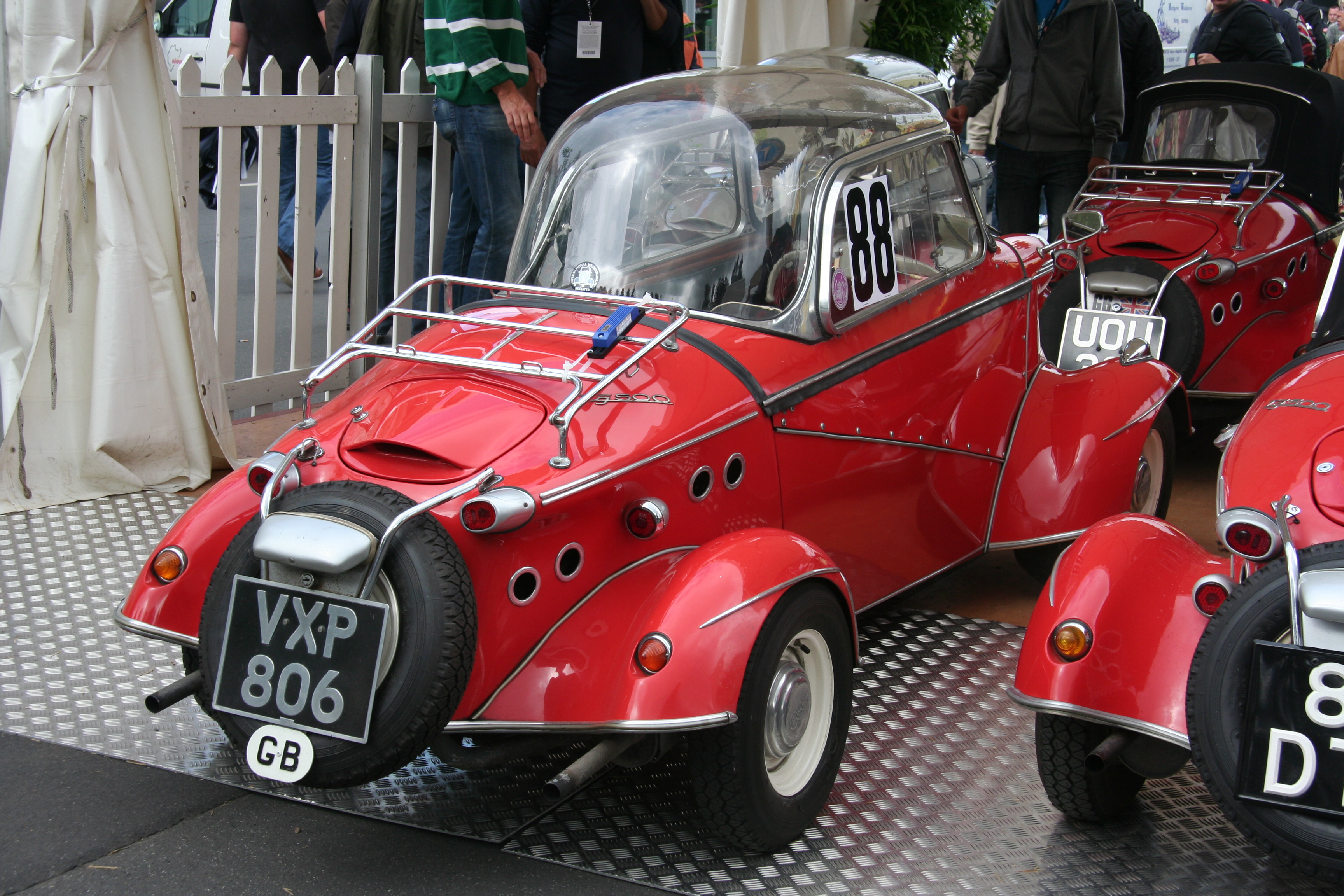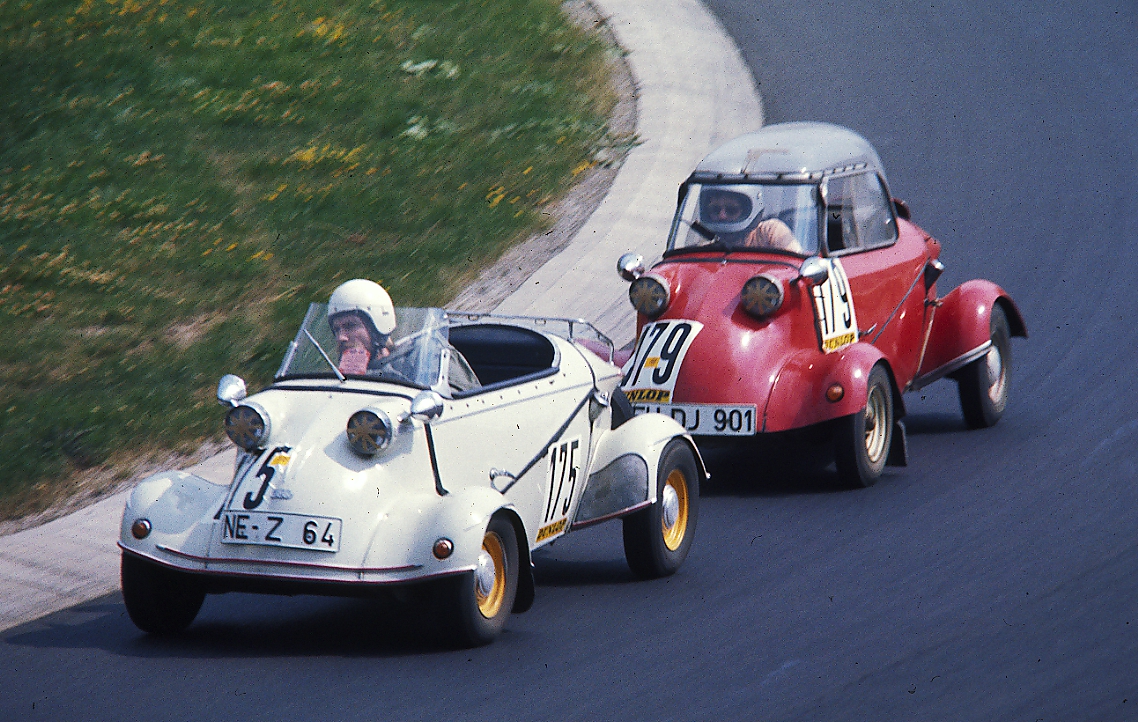FMR Tg500 on:
[Wikipedia]
[Google]
[Amazon]
The FMR Tg500 was a
 The narrow body, and corresponding low frontal area, was achieved with tandem seating, which also allowed the body to taper like an aircraft fuselage, within a practical length. The tandem seating also centralized the mass of the car along the longitudinal axis which, combined with the low center of gravity, low weight, and wheel placement at the vehicle's extremes, gave the Tg500 good handling characteristics. A more minor advantage of tandem seating was that it made a mirrored export version to countries that drive on the left superfluous.
The center of gravity of the car was at the rear seat, which meant that the presence or absence of a passenger did not change the handling characteristics of the car.
The narrow body, and corresponding low frontal area, was achieved with tandem seating, which also allowed the body to taper like an aircraft fuselage, within a practical length. The tandem seating also centralized the mass of the car along the longitudinal axis which, combined with the low center of gravity, low weight, and wheel placement at the vehicle's extremes, gave the Tg500 good handling characteristics. A more minor advantage of tandem seating was that it made a mirrored export version to countries that drive on the left superfluous.
The center of gravity of the car was at the rear seat, which meant that the presence or absence of a passenger did not change the handling characteristics of the car.
 In stock form, the Tg500 accelerated from rest to in 28 secondsMotorbase - Messerschmitt TG500 Tiger and went on to a top speed of .Motorbase - Messerschmitt FMR Tiger 500 Tiger: different site from previous At a similar price, the first series of the
In stock form, the Tg500 accelerated from rest to in 28 secondsMotorbase - Messerschmitt TG500 Tiger and went on to a top speed of .Motorbase - Messerschmitt FMR Tiger 500 Tiger: different site from previous At a similar price, the first series of the
sports car
A sports car is a car designed with an emphasis on dynamic performance, such as handling, acceleration, top speed, the thrill of driving and racing capability. Sports cars originated in Europe in the early 1900s and are currently produced by ...
built by Fahrzeug- und Maschinenbau GmbH, Regensburg (FMR) from 1958 to 1961. Based on the Messerschmitt Kabinenroller
The ''Messerschmitt Kabinenroller'' (Messerschmitt Cabin Scooter) was a series of microcars made by RSM
Messerschmitt from 1953 to 1956 and by ''Fahrzeug- und Maschinenbau GmbH, Regensburg'' (FMR) from 1956 to 1964. All the Messerschmitt and FMR ...
monocoque
Monocoque ( ), also called structural skin, is a structural system in which loads are supported by an object's external skin, in a manner similar to an egg shell. The word ''monocoque'' is a French term for "single shell".
First used for boats, ...
, which otherwise was a platform
Platform may refer to:
Technology
* Computing platform, a framework on which applications may be run
* Platform game, a genre of video games
* Car platform, a set of components shared by several vehicle models
* Weapons platform, a system or ...
for three-wheeler
A three-wheeler is a vehicle with three wheels. Some are motorized tricycles, which may be legally classed as motorcycles, while others are tricycles without a motor, some of which are human-powered vehicles and animal-powered vehicles.
Overv ...
s, the Tg500 was a four-wheeled car with a two-stroke
A two-stroke (or two-stroke cycle) engine is a type of internal combustion engine that completes a Thermodynamic power cycle, power cycle with two strokes (up and down movements) of the piston during one power cycle, this power cycle being comple ...
straight-two engine. FMR had taken over production of the KR200 from Messerschmitt
Messerschmitt AG () was a German share-ownership limited, aircraft manufacturing corporation named after its chief designer Willy Messerschmitt from mid-July 1938 onwards, and known primarily for its World War II fighter aircraft, in partic ...
in 1956. While the KR200 still used the Messerschmitt name and logo, the Tg500 was badged as an FMR.Wagner
Wilhelm Richard Wagner ( ; ; 22 May 181313 February 1883) was a German composer, theatre director, polemicist, and conductor who is chiefly known for his operas (or, as some of his mature works were later known, "music dramas"). Unlike most op ...
, p. 169
"Tg" unofficially stood for Tiger. The "Tiger" name was claimed in Germany by Krupp
The Krupp family (see pronunciation), a prominent 400-year-old German dynasty from Essen, is notable for its production of steel, artillery, ammunition and other armaments. The family business, known as Friedrich Krupp AG (Friedrich Krup ...
, who used it on one of their trucks. There was also a Panhard Dyna Z Tiger at the same time.
Features
The Tg500 incorporated several features from the Kabinenroller platform on which it was based, including the narrow body with tandem seating, the transparent acrylicbubble canopy
A bubble canopy is an aircraft canopy constructed without bracing, for the purpose of providing a wider unobstructed field of view to the pilot, often providing 360° all-round visibility.
The designs of bubble canopies can drastically vary; so ...
, the low stance, and the direct steering.
Tandem seating
Bubble canopy
Except for the Sports Roadster model, entry to the Tg500 was through a canopy door hinged on the right side of the vehicle. The door included both the windows (windshield, window frames on all but the Roadster models, folding top on Roadster and Kabrio models, and acrylic bubble on other versions) and the frame in which it was set, extending from the right side of the monocoque tub to the left. On Sport Roadster models, the canopy was fixed and there was neither a top nor any windows at all, only a tonneau cover. The bubble top on the Tg500 was the same as the one used on the KR200.Engine and transmission
The Tg500 ran on a air-cooled two-cylindertwo-stroke engine
A two-stroke (or two-stroke cycle) engine is a type of internal combustion engine that completes a power cycle with two strokes (up and down movements) of the piston during one power cycle, this power cycle being completed in one revolution of t ...
positioned transversely over the rear wheels. The engine, designed by Fichtel & Sachs
ZF Sachs AG, also known as Fichtel & Sachs, was founded in Schweinfurt in 1895 and was a well-known German family business. At its last point as an independent company, the company name was Fichtel & Sachs AG.
In 1997, the automotive supplier wa ...
, was built by FMR. The Dynastart
SIBA Elektrik G.m.b.H is a former German automotive electrical manufacturer, noted as manufacturers of the Dynastart combined starter motor and dynamo, used on many cars, motorcycles and scooters in the 1950s and notable for providing an electric m ...
starter/generator unit was belt driven, and had a fan at each end of the unit, one to cool each cylinder of the engine. Unlike the KR175 or the KR200, the Tg500 had a reverse gear in its transmission, which was part of a transaxle
A transaxle is a single mechanical device which combines the functions of an automobile's transmission, axle, and differential into one integrated assembly. It can be produced in both manual and automatic versions.
Engine and drive at the ...
unit.
Controls
The controls of the Tg500 were similar to those of the KR200 except for the Tg500's single starting mode for the engine and its H-pattern gearshift with reverse gear and no auxiliary lever. Atachometer
A tachometer (revolution-counter, tach, rev-counter, RPM gauge) is an instrument measuring the rotation speed of a shaft or disk, as in a motor or other machine. The device usually displays the revolutions per minute (RPM) on a calibrated anal ...
was offered as an optional replacement for the clock.
Suspension and brakes
Apart from the use of 4.40 x 10 tires all around and an increase in front track from to , the front suspension and steering were the same as that on the KR200. The rear suspension was fully independent, with universal joints at both ends of each halfshaft, located by lower wishbones and coil springs with concentrically mounted shock absorbers. Unlike the three-wheeled ''Kabinenrollers'', which had cable-operated mechanical brakes, the Tg500 had hydraulic brakes. Canadian Driver - Messerschmitt, 1953-1962Performance
 In stock form, the Tg500 accelerated from rest to in 28 secondsMotorbase - Messerschmitt TG500 Tiger and went on to a top speed of .Motorbase - Messerschmitt FMR Tiger 500 Tiger: different site from previous At a similar price, the first series of the
In stock form, the Tg500 accelerated from rest to in 28 secondsMotorbase - Messerschmitt TG500 Tiger and went on to a top speed of .Motorbase - Messerschmitt FMR Tiger 500 Tiger: different site from previous At a similar price, the first series of the Austin-Healey Sprite
The Austin-Healey Sprite is a small open sports car produced in the United Kingdom from 1958 until 1971. The Sprite was announced to the press in Monte Carlo by the British Motor Corporation on 20 May 1958, two days after that year's Monaco Gran ...
accelerated from rest to in 21 seconds and went on to a top speed of .Motorbase - Austin-Healey Sprite Mk I
Data
* Heating/air conditioning: via exhaust heat exchanger / none * Wheel size: * Weight, empty / full load: * Track, front / rear: * Fuel consumption: * Top speed: * Time to : 27.8 seconds * Price: DM 3,650.00 (46% of anAustin-Healey Sprite
The Austin-Healey Sprite is a small open sports car produced in the United Kingdom from 1958 until 1971. The Sprite was announced to the press in Monte Carlo by the British Motor Corporation on 20 May 1958, two days after that year's Monaco Gran ...
)
References
Citations
Sources
* * * * * * *External links
* {{DEFAULTSORT:Fmr Tg500 Microcars Rear mid-engine, rear-wheel-drive vehicles Rear-engined vehicles Sports cars Cars introduced in 1958